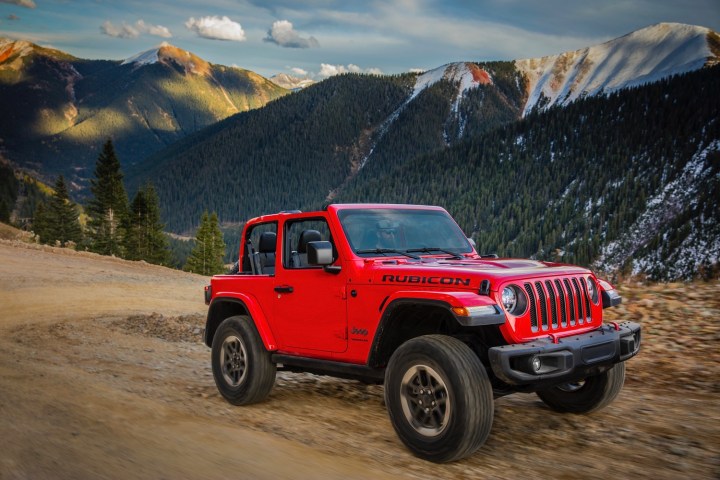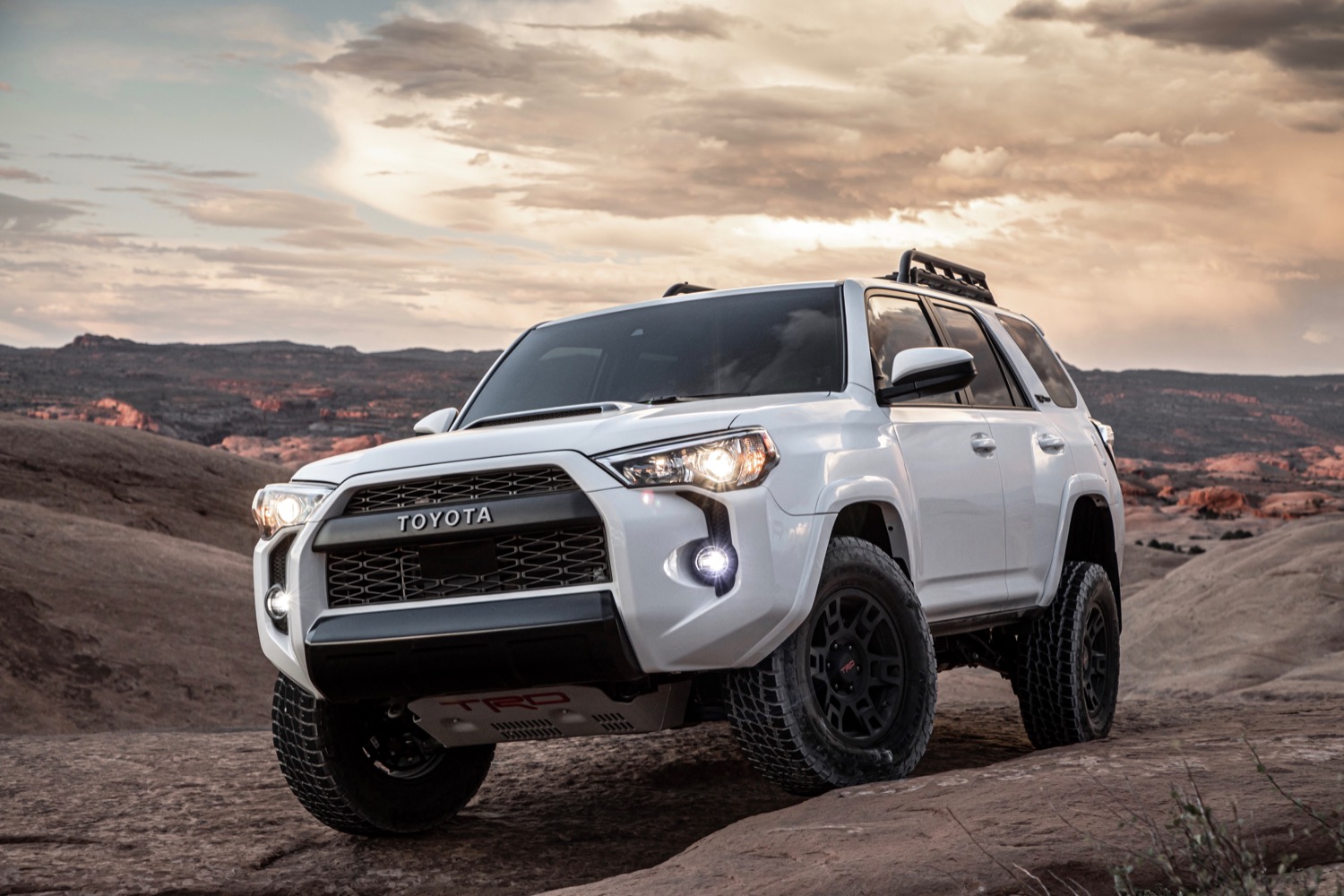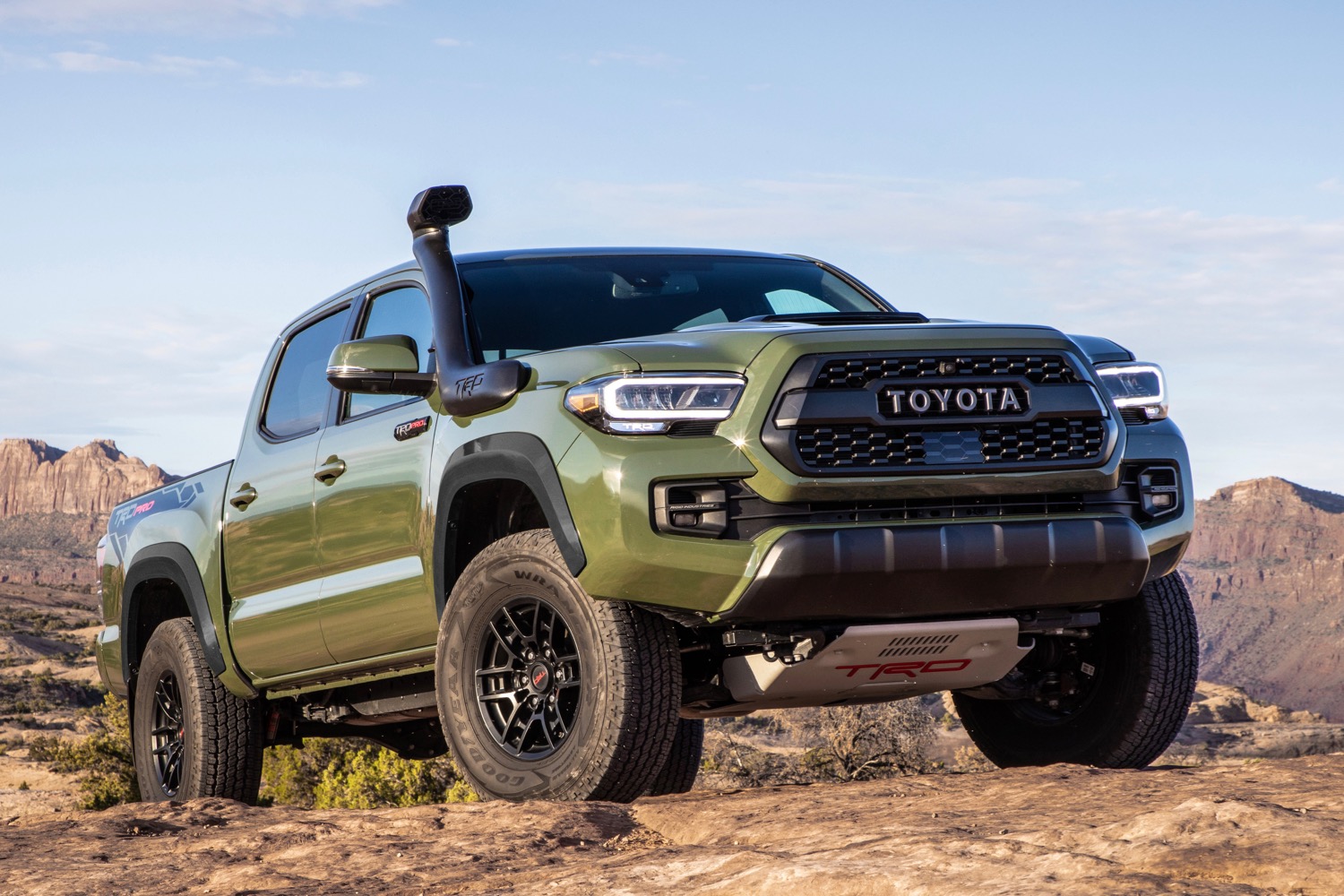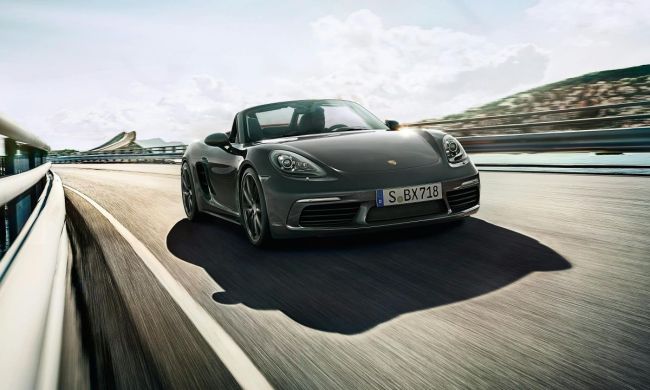A night under the brilliant, undiluted stars is one of the best ways to escape the stresses of daily life, but to do it right, you’ll need supplies. Firewood, graham crackers, and chocolate are obvious choices, but the right vehicle can be the gooey marshmallow that brings it all together.
A lot goes into choosing the ideal camping car. It has to get you there, for starters, so it must be adventurous and at least somewhat tough. It should also be reliable, with lots of cargo room and seating for all your friends and gear. We’ve already done a list of our favorite trucks and the best 4x4s, so when we set out to choose the best cars for camping, we focused on fun. That’s the point of camping, right?
Citroën Cactus M

This one may be a concept, but this beach car is just too perfect an outdoor adventurer for us to exclude. First off, the cabin is covered in water-resistant neoprene, which means you can hoof it to the coast and not worry about wet surfing gear, clothes, or spilling a drink. There’s an integrated tent out back as well, and the rear seats fold to create a sleeping area for two.
Because it’s weird and French and awesome, the Cactus M embraces a special kind of eccentricity. As such, the entire exterior is coated with an air-filled “second skin” that prevents scratches, bumps, and damage from saltwater. Oh, and it has its own surfboard. It’s not headed to production, however.
Pontiac Aztek

The worst car ever made might just be the best camping trip companion. Despite its fugly looks and bad reputation, the midsized crossover is chock-full of crafty features, including a swing-open tailgate, a removable cargo tray (pong anyone?), and a center console that doubles as a cooler. If those features weren’t enough, the available camping package includes an air compressor, an inflatable mattress, and of course, an attachable tent.
Even without the extra knickknacks, the Aztek is plenty capable. With the rear seats down, the vehicle boasts 93.5 cubic feet of cargo space and a 10-speaker stereo system with rear controls. Just make sure to face your tent away from the car; a Pontiac Aztek is not the first thing you want to see in the morning.
Honda Element

The Element is famous for its easily washable urethane floor, but an easy cleanup isn’t the only reason the SUV appears on our list. The rear seats, which are covered in stain-resistant fabric, can recline, fold up, and be removed for extra cargo room. It’s a tall vehicle as well, which makes it easy to store awkward items like water tanks or even grills.
In addition, Honda offers a genuine factory hatch tent as an accessory. It measures 10 feet by 10 feet and sleeps six. Add in available all-wheel drive and this lunchbox on wheels could be the perfect fit.
Chevrolet Tahoe

The Chevrolet Tahoe (and its stretched Suburban sibling) isn’t just for Uber drivers. The Tahoe is one of the last old-school SUVs, meaning it’s built for towing and hauling and gear and has a modicum of off-road capability. The redesigned 2021 Tahoe also adds plenty of tech.
Sharing a basic platform with the glitzier Cadillac Escalade, the Tahoe is available in a choice of two gasoline V8 engines, or a turbo-diesel inline-six. All three should be up to the task of moving your gear to a campsite, while the diesel is expected to offer better fuel economy (final numbers aren’t available yet). Available air suspension gives the Tahoe a more comfortable ride than a typical big SUV, and the Z71 model adds all-terrain tires, hill descent control, and other features for greater off-road capability.
The latest Tahoe gets a standard 10.0-inch central touchscreen and 8.0-inch digital instrument cluster. A built-in Wi-Fi hotspot and Apple CarPlay/Android Auto compatibility are standard as well. A head-up display is available as an optional extra, as well as an array of nine cameras to make parking this beast at a campsite easier. Who said vehicles like this can’t have tech?
Scion xB

What’s better than one lunchbox on wheels? Two lunchboxes on wheels!
Joking aside, this rolling toaster is perfectly suited for light camping duty given its almost offensively square shape. You can jam tents, sleeping bags, folding chairs, and just about anything else you can think of inside the xB, and better yet, the first-gen five-door returns an Environmental Protection Agency-rated 32 mpg highway with the five-speed manual transmission (1 mpg less with the four-speed automatic). Take that, aerodynamics.
The xB was killed off with the rest of the Scion brand in 2016, but used examples should be easy to find. The xB is just a Toyota in a funkier wrapper, meaning it can stand up to plenty of abuse.
Subaru Baja

It was tough to decide just which Subaru would appear on our list first, but in the end, we settled on the only “truck” the company has ever made. It was either that or the BRZ.
Built before the active lifestyle automobile trend was born, the Baja combined car-like handling with truck-like utility in a funky but likable way. It wasn’t received particularly well over its four-year lifespan, but it had character, and sometimes that’s all you need. Add in Subaru hallmarks like all-wheel drive, solid reliability, and healthy fuel economy ratings, and you’ll understand why Bajas are so popular with aficionados of nature. Is there an automaker more closely tied to camping than Subaru? If there is one, it’s probably the brand behind our next entrant.
Jeep Wrangler

The Wrangler is one of most emblematic off-roaders ever built, and for good reason. The SUV’s body-on-frame construction and rigid live axles give it a toughness newer crossovers can’t match, and the culture behind it is as strong as any car. Newer models have added electronic traction control, premium sound systems, and leather interiors, but the Wrangler is still a dirty dog at heart.
There isn’t a copious amount of room inside for coolers and gears (unless you opt for one of Jeep’s countless camping accessories, or for reputation Gladiator pickup truck), but who cares? You can take the doors and roof off!
Chrysler Pacifica

Minivans get a bad reputation, but if you can get past their manatee-like exterior, these family haulers are some of the most practical and tech-rich vehicles on the road. Take the new Pacifica, for instance, which offers a generous 197.8 cubic feet of storage space with the third row stowed. With all the seats up, this thing can haul up to eight people around, but there’s a lot more to offer than sheer volume.
Did your tentmate track dirt all over the sleeping bag again? No worries, the Pacifica has a built-in vacuum. Have too much gear in your hands to open the door? Easy fix; you can open this van by waving your foot around. There are also eight USB ports in total for smartphone charging, two 12-volt outlets for blowup mattresses or heaters, and best of all, 13 cupholders. That’s right, 13. That’s a lot of … soda.
If you’re operating on a budget, and are willing to forgo some creature comforts, the Chrysler Voyager is a lower-priced version of the Pacifica with the same capacious, versatile interior.
Honda Ridgeline

If there is one word to describe Honda’s only truck, it’s “quirky.” Everything about the Ridgeline is just a little bit off, but that’s certainly not a bad thing. As we found out when we drove it, the truck’s weirdness is one of its best attributes.
More impressive than the Ridgeline’s ride, handling, and engine power are genius features like the dual-action tailgate, which can swing open like a door or be folded down. The truck also has a lockable trunk and an audio system inside the bed, and new tech like adaptive cruise control, collision mitigation braking, and lane-keeping assist keep you safe to and from the campsite.
Mini Clubvan Camper

Of all the car brands in the world, Mini is one of the last you’d associate with roughing it. In an attempt to change that, the automaker released three camping-centric concepts back in 2013, the most memorable of which was the Mini Clubvan Camper.
This car differs from the rest of our field due to its limited occupancy. With a cot on one side and an extendable kitchenette on the other, there isn’t much room for anyone except the driver, meaning this compact prefers to camp solo. It’s a shame because, with its propane stove and chest fridge, this thing is a party on wheels. There’s even a handheld shower, which means your vacation stops whenever you want it to.
Volkswagen Golf Alltrack

It would appear the only way Americans like their wagons is with a lift, and while that might not be a styling decision we agree with, it does come with the benefit of versatility. Taking a Golf Sportwagen into the boonies for a spot of camping might be risky business, but with the Alltrack’s 4Motion all-wheel-drive system, a little bit more ground clearance, underbody protection, and plastic moldings around the wheel wells, you can venture (within reason) into the great unknown. Better yet, the Alltrack and its 66.5 cubic feet of cargo capacity starts at a supremely reasonable $26,895. Act fast if you want a new one, though. Volkswagen confirmed both the Alltrack and the Sportwagen will retire by the end of 2019.
Toyota 4Runner

We’ve mentioned some creative camping car solutions thus far, but let’s not forget the gold standards. Though the 4Runner is long overdue for an update (at least Toyota added Apple CarPlay and Android Auto for the 2020 model year), its rugged body-on-frame platform and dependable four-wheel-drive system can take you just about anywhere.
If you spring for the TRD Pro and its increased ride height, bigger tires, and skid plates, you’ll face few obstacles. The alien front fascia may not appeal to everyone (we happen to dig it), but it’s hard to argue with up to 89.7 cubic feet of cargo capacity and 5,000 pounds of maximum towing. Need another reason? The back window goes down so you can air out the cabin — and its inhabitants — after a smelly few days in the woods. That’s fun for the whole family.
Nissan Xterra

We shed a tear in 2015 when Nissan announced the Xterra was ending production. The quirky model remains a favorite among adventurers for its dependability and creative cargo solutions. In addition to a solid 65.7 cubic feet of maximum cargo room, there are storage areas within the cabin floor and one built into the design of the construction-grade aluminum roof rack. To access those top-stored items, the Xterra has built-in bumper steps. Like the Honda Element, cleaning the interior is a breeze, thanks to appropriately-named “Easy Clean” materials.
If you score a six-speed manual version, the Xterra and its 4.0-liter V6 is even fun to drive. Finding a four-wheel-drive version in good shape is becoming harder and harder these days, as people are realizing what a great adventure vehicle the Xterra was, but you should budget about $15,000 to $20,000 for a late production model.
Nissan’s recent XMotion concept also hints at a possible return of the Xterra, though nothing is official yet, while the Frontier pickup truck remains in production on the same F-Alpha platform. The Frontier is essentially an Xterra with a bed, making it another good option for a rugged and simple camping vehicle.
Subaru Ascent

The Subaru Baja is just plain cool, but if you need more space, give the Ascent a shot. This three-row, seven-seat SUV is the biggest production Subaru ever, boasting 153.5 cubic feet of total interior volume, including 72.6 cubic feet of cargo space with the two rear rows of seats folded down. It’s also got 19 cupholders. To keep everyone entertained, Subaru offers a built-in Wi-Fi hot spot and up to eight USB ports.
Subaru promises a tow rating of 5,000 pounds when properly equipped, which is pretty good for a vehicle in this class. The Ascent’s standard roof rails were also designed to handle rooftop tents, according to Subaru. Like every Subaru except the BRZ, the Ascent offers all-wheel drive as standard equipment. The Ascent isn’t a proper off-roader like some of the other vehicles on this list but, as we found out on our test drive, it holds its own on gravel and dirt.
If you don’t need three rows of seats or that record-breaking amount of cupholders, the Subaru Outback wagon shares the Ascent’s all-wheel-drive system, turbocharged engine, and basic platform.
Toyota Tacoma

The Toyota Tacoma is one of the best-selling trucks in the U.S. In fact, it’s so popular that Toyota Tacoma has almost become a household name. If you buy a Tacoma, prepare to be enthusiastically accepted into the “Taco” family, as those who own Tacomas are often very passionate about them. It’s easy to get pulled into the friendly (and thriving) Tacoma community on Toyota forums and subreddits.
The Tacoma is a versatile truck, adaptable to a variety of applications. While users can choose from an exhaustive list of configurations, availability for this model can vary. Still, with a selection of cab sizes, bed configurations, and off-road capabilities, odds are you can find the Tacoma that’s perfect for you.
Getting a basic Tacoma isn’t more expensive than most other trucks, but if you start adding features you might add up with a costly vehicle. For a few extra bucks, you can upgrade your truck to suit your needs: overland travel, rock crawling, or towing, to name a few.
To keep costs lower, you can find many high-quality accessories made by third-party manufacturers; they are more affordable since they’re not the Toyota brand, but they’ll still level up your truck. Aftermarket bumpers, light bars, and rooftop tents are all at your disposal as soon as you get your truck home. Tacomas are so cool it’s hard not to succumb to the temptation to trick yours out.
Since trucks are built to be rugged, you won’t have to spend a lot of time or money in keeping them clean and polished. The 2020 model features even more convenient tech options, like Android Auto. The TRD Pro Tacoma model comes with a host of useful off-road features, including a nifty-looking snorkel to keep dirt out of the engine air intake.



